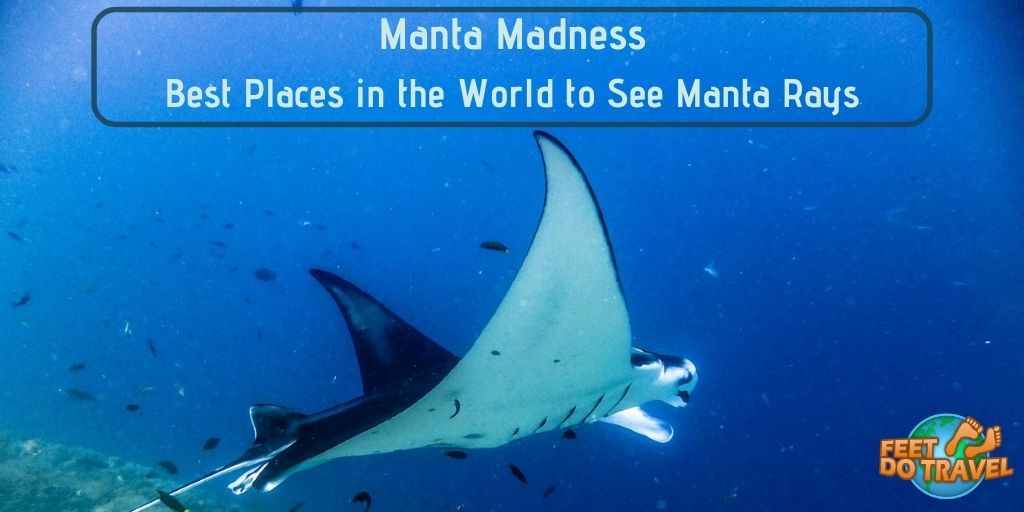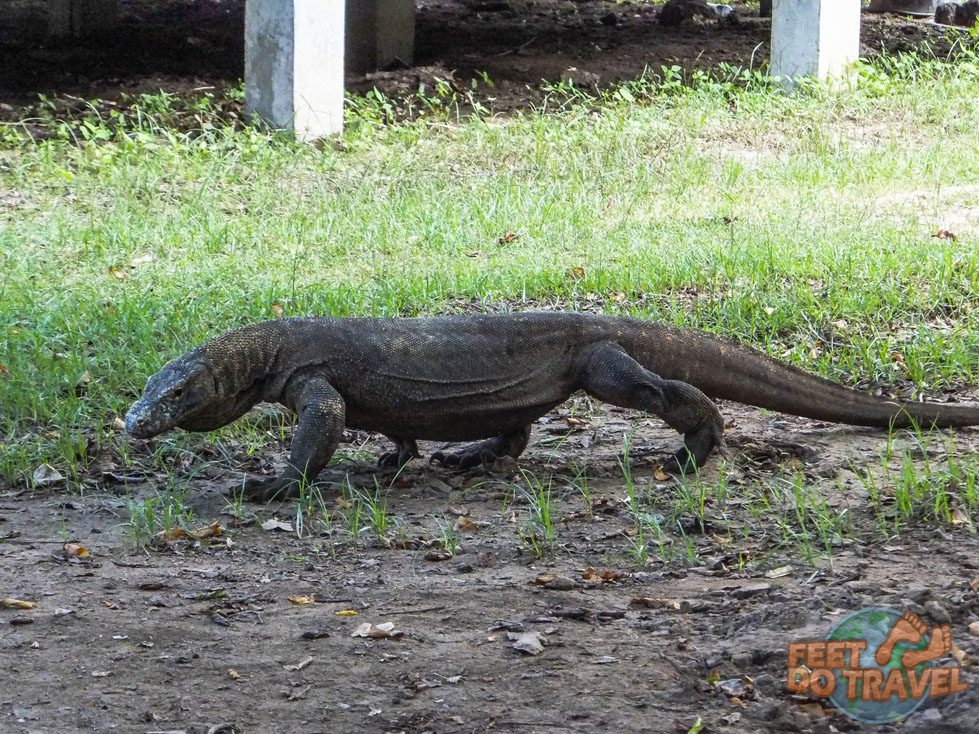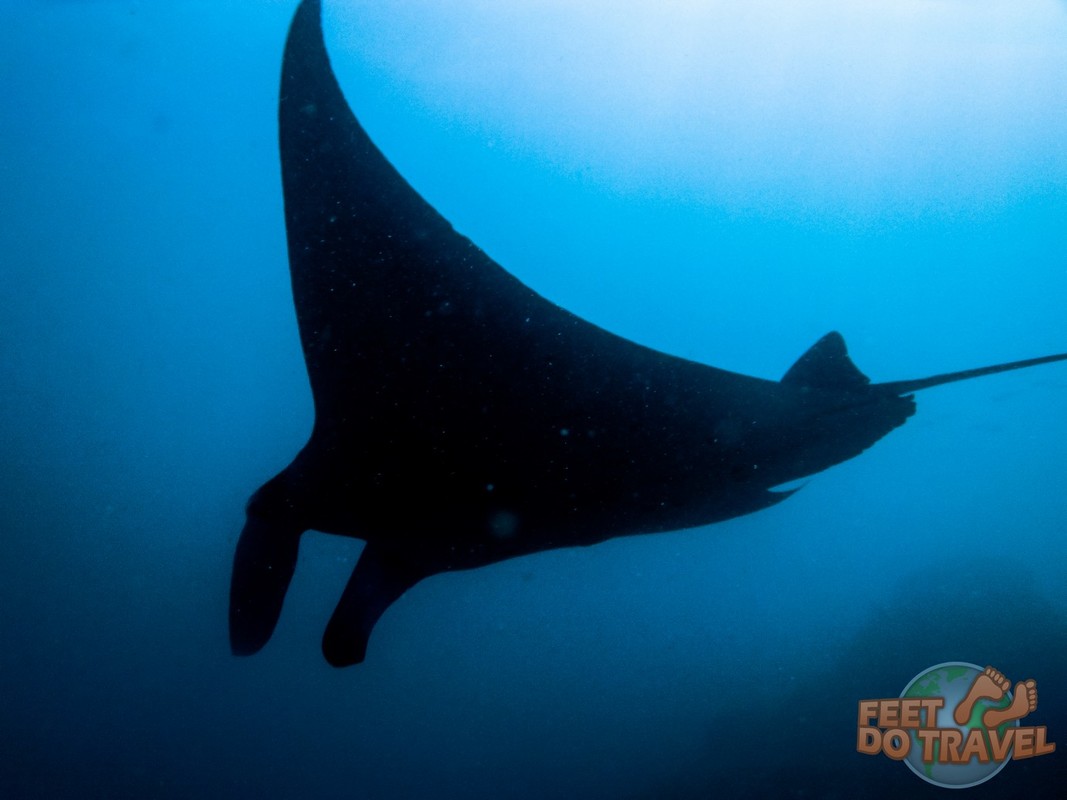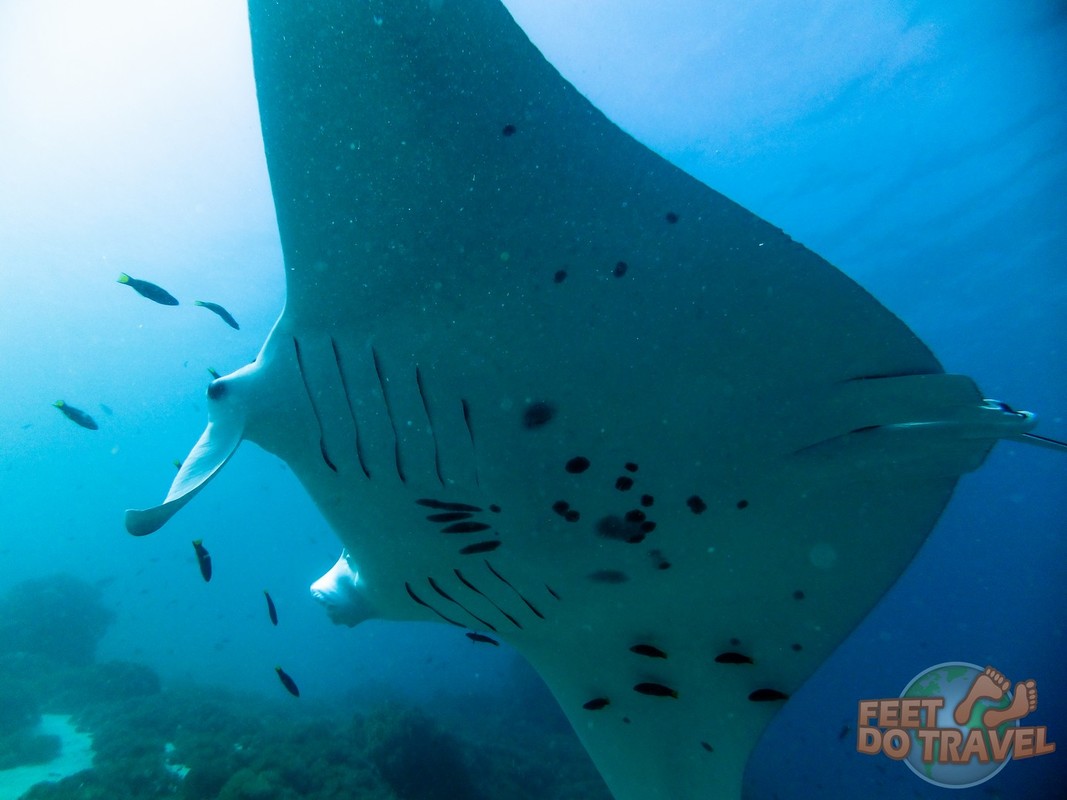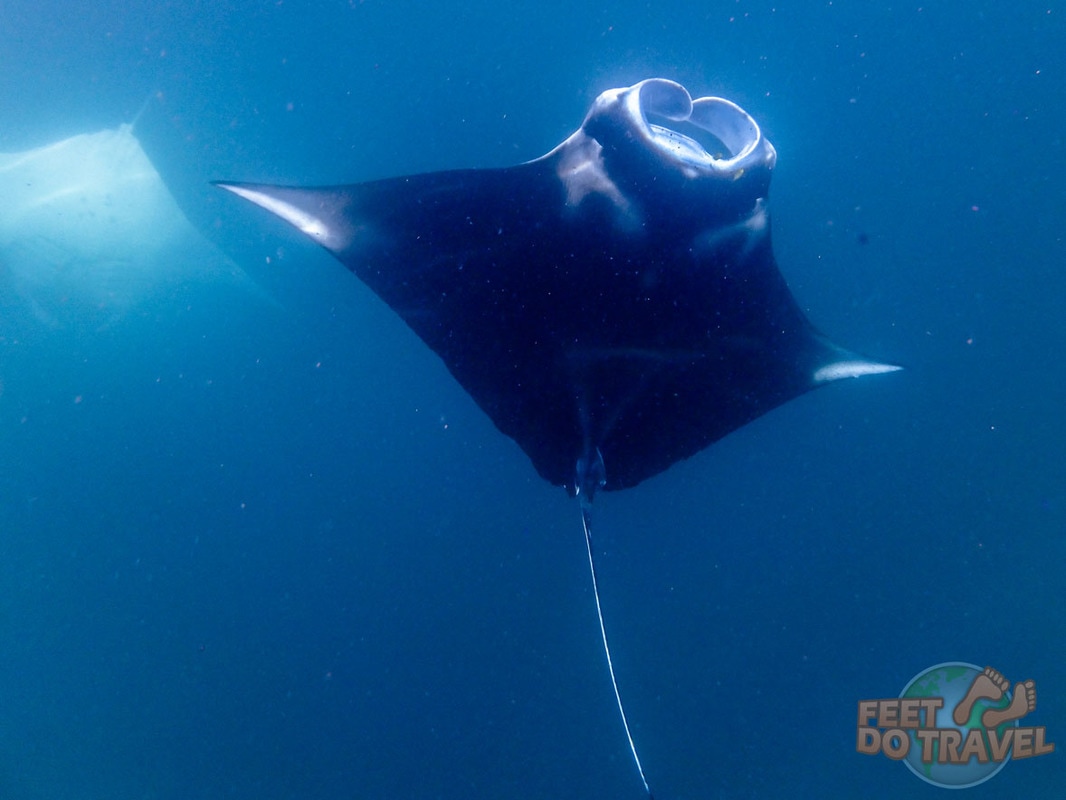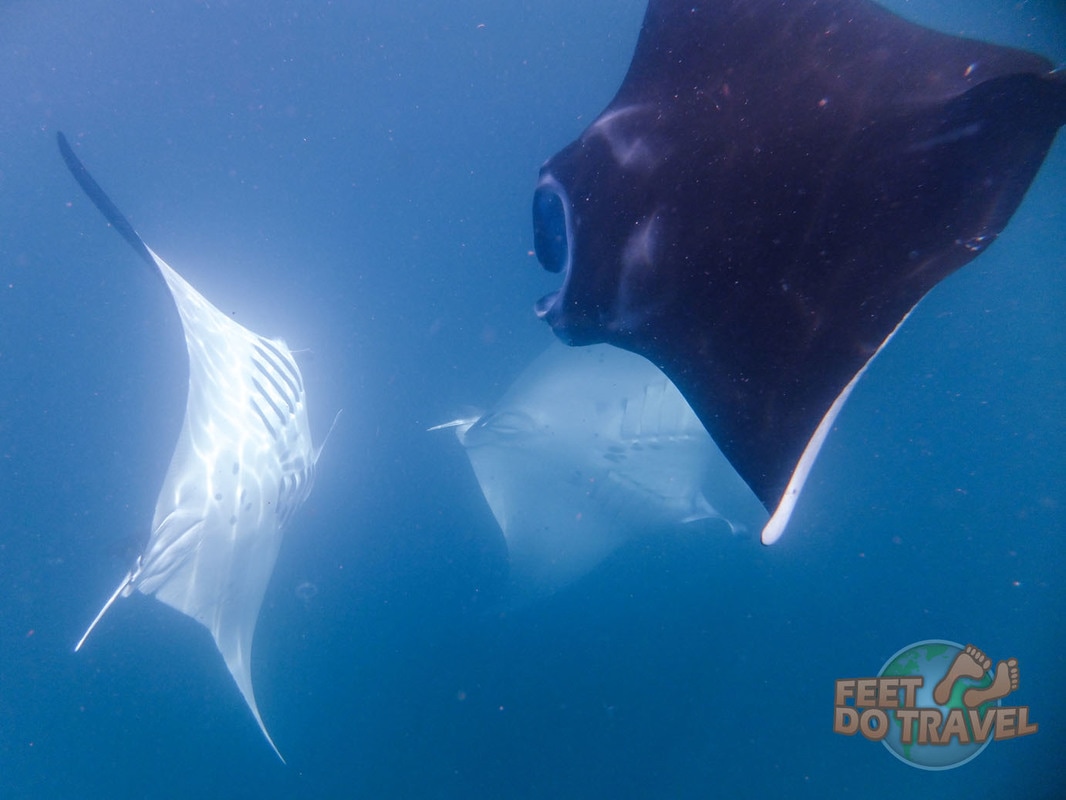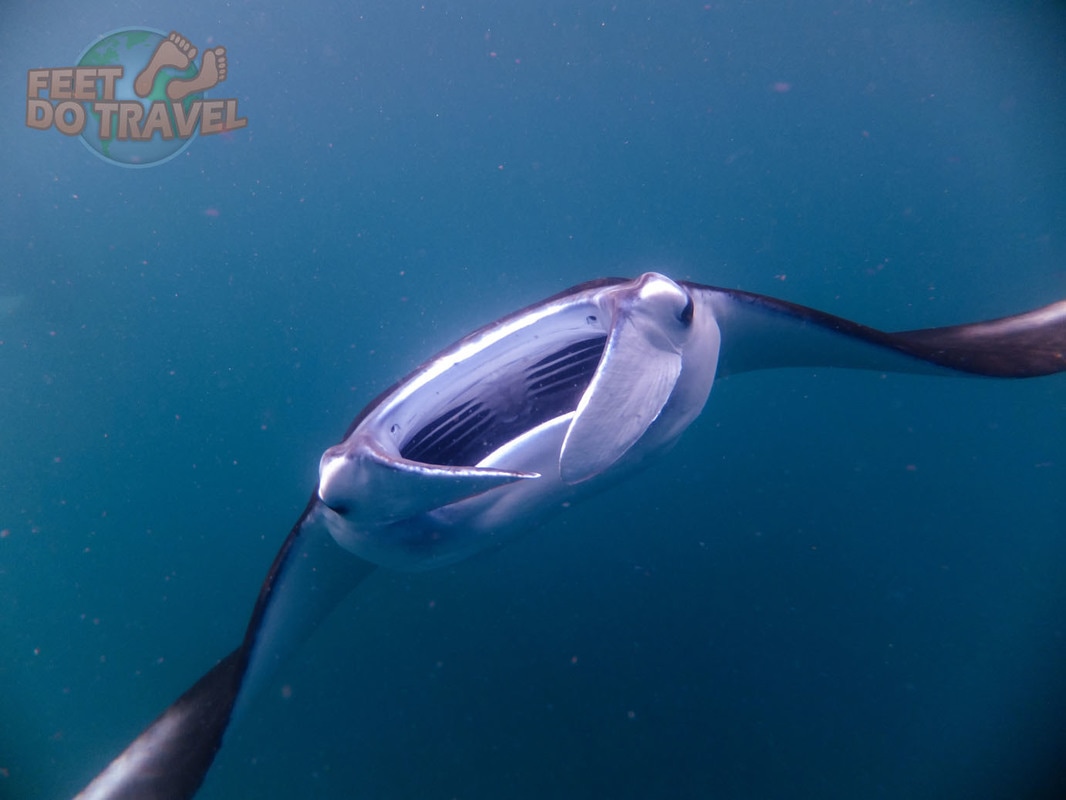When snorkelling in Sangalaki, Borneo, we saw mantas feeding on the surface. Nothing could prepare us for how we would feel when we had our first encounter with these majestic giants of the ocean.
We have been lucky to have had a few experiences with manta rays which weren’t just fleeting glimpses. When scuba diving in Komodo, Raja Ampat, and Nusa Penida, we hung around watching them being cleaned for hours.
This article shares our amazing encounters, and if you aren’t a huge manta fan, I hope you will learn more about this intelligent, graceful fish.
We feel you can never have enough manta action, and we definitely still want more! Feet Do Travel share their Manta Madness.
Injured mantas have been known to ask scuba divers to help them, allowing humans to free them from entangled fishing line when they have become entangled. To do this, mantas slow down their swimming speed so the diver can cut the fishing line or net from around their bodies.
Diving with Manta Rays in Komodo National Park
Komodo is famous for its giant lizards, the Komodo Dragon, but it’s also one of the best places in the world to see the majestic Manta Ray. Our diving friend Bert managed to capture a video of around 70-100 mantas as they swam past him just under the surface as he finished his dive. At first he thought he was videoing one manta, then all of a sudden a huge manta-train came from behind and he was surrounded. Mantas were to the left of him, to the right and underneath, it took around three minutes for the whole group to pass by! This encounter was special enough for PADI to share on their Facebook page.
In 1991, Komodo became a UNESCO World Heritage Site as a Terrestrial Park to protect the Komodo Dragons, however the plight of the Manta Ray was concerning, and conservation goals were expanded to protect the entire biodiversity of marine and terrestrial life.
As we descended, we swam towards an underwater hill and there in front of us was a manta, gently floating around getting cleaned. We were elated when we swam closer and counted five.
During the three dives we probably spent around 2.5 hours with these graceful creatures. We had the privilege of spending around 45 – 60 minutes each time with between five and seven mantas, watching in awe as they swam silently and effortlessly around and around the coral mountain.
Each time they swam over us, they became closer and closer as we hovered near the sandy bottom.
Their eyes were looking at us. It was obvious they were aware of who we were.
There were still a few more surprises in store for us; the elusive Devil Ray came swimming by, if we blinked we would have missed it. Thank goodness we were watching all the action intently and had the camera ready.
Before we began to ascend, the sun moved around in the sky and shone into the ocean showing off the manta’s stunning silhouette shape. Just when we didn’t think the manta could be any more beautiful.
Snorkelling with Mantas in Sangalaki
You don’t have to be a diver to see mantas, one of our best experiences for observing manta behaviour was snorkelling in Sangalaki. We were sitting on our dive boat at a surface interval, then saw manta fins just on the surface. You didn’t have to ask us twice if we wanted to jump in!
We grabbed our mask and snorkels and dropped in close by making sure we were far enough away not to startle them.
Both organisations are part of the MMF (Marine Megafauna Foundation) and have a visual database of resident and migrating mantas around the world. Scuba Divers and snorkelers are encouraged to send any photos showing the spot pattern on the underbelly because this is their unique ID like a human finger print. Manta Matcher can track and better protect mantas with your help.
*We received an email response to advise that one of the mantas we had sent was brand new to their database.
At a cleaning station we nicknamed Manta Mount, we saw a medium sized manta (around two to three meters). We watched him for about 20 minutes as he also swum swim around and over us again and again, it was wonderful.
Best places in the world for viewing Manta Rays
There are many places in the world for manta ray viewing so take your pick! Listed below are the best sites according to Dive Magazine and Diviac Travel. We have seen mantas in Sangalaki, Komodo, Raja Ampat and Nusa Penida all of which are in Indonesia.
- Raja Amput, Indonesia
- Komodo National Park from Flores, Indonesia
- Air Atoll & Baa Atoll, Maldives
- Hawaii
- Revillagigedos Islands & Socorro Island, Mexico
- Isla de la Plata, Ecuador
- Yap, Micronesia
- Rangiroa, Manihi and Fakarava atolls in French Polynesia
- Uepi Island Manta Rays, Solomon islands
- Yasawa Island, Fiji
- Coral Bay & Ningaloo Reef, Western Australia
- Ishigaki Island, Japan
- Cabo Marshal, Galapagos
- Koh Bon & Similan Islands, Thailand
- Sangalaki on the Indonesian side of Borneo
- Nusa Lembongan & Nusa Penida which can both be reached from Bali
- The word “manta” is Spanish for cloak.
- There are two different species of mantas (before 2009, there was only one category of species, but then scientists realised they were different and split them into two). Manta Alfredi also know as Reef Mantas tend to be the species you see travelling or being cleaned in groups. Manta Birostis (the Oceanic or Giant Manta) are larger and more solitary.
- The Oceanic Manta is often found near the surface but can also dive to depths of 1,000 metres.
- A full grown Oceanic Manta’s wing span can reach up to 7 metres (23 feet) and weigh up to 2 tonnes.
- The Reef mantas are smaller and grow up to 3 to 3.5 metres (9-11.5 feet) weighing up to 1.4 tonnes.
- Chevron pattern is the most popular but there is also all black.
- Mantas are sexually mature around 10 – 15 years old.
- Gestation period is 13 months and they give birth to one pup at a time every other year.
- Mantas can have as many as 15-18 pups in their lifetime,
- Mantas give birth to live young but have never been filmed giving birth in the wild.
- Mantas live to at least 50 years old however scientists still know little about this and continue to study.
- They have around 300 tiny teeth – all of which are useless as they are filter feeders.
If you are want to support the Marina Megafauna Foundation's work protecting mantas, adopt a manta today!
We would love to know your thoughts on mantas, whether you are a scuba diver or not, please share with us in the comments section below.

Book your holiday hotel or weekend break through our website with booking. com. Visit our Hotel Booking Page and search as normal. There is no extra cost to you but you will be helping to keep Feet Do Travel running longer.
Bali - Is Sanur Worth Visiting? You May Be Surprised
Searching for Street Art in Canggu, Bali
15 Things to Do in Canggu, Bali
Lembongan - Bali, but Better!
Gili Air - The Perfect Island?
Gili Trawangan - Not Just A Party Island
Gili Meno - The Island of Love
10 Must Try Indonesian Dishes
Gili Gede - The Secret Gili Islands
Gili Asahan - The Secret Gili Islands
Gili Sudak and Gili Kedis - The Secret Gili Islands
Kuta Lombok - The New Kuta Bali?
Is Pink Beach Lombok Worth Visiting?
Wonderful Waterfalls of Lombok
Tarsiers and a Monkey Selfie
Jewels of Java - Borobudur & Prambanan
Indonesian Orangutan Adventure
Raja Ampat on a Budget
Are you a Scuba Diver? Check out these related links:
Diving in Borneo - Always Awesome
Diving the World's Number 1 Dive Site - Sipadan
Scuba Diving the Gili Islands
Diving Raja Ampat
Lembeh - A Magical Muck Diving Experience
USS Liberty in Bali - Highly Wreck-Ommended
Nusa Penida: Diving with Mola Mola, the Ocean Sunfish
Diving in Dauin, Negros: Muck Diving in the Philippines
Sardine Run, Moalboal,Cebu: Diving the Philippines
Diving Sogod Bay, Leyte, Philippines: An Undiscovered Paradise

